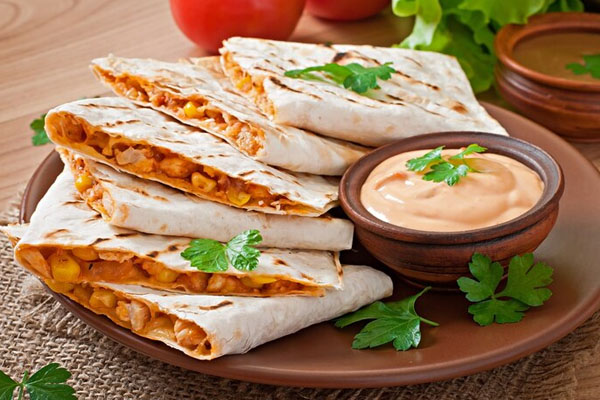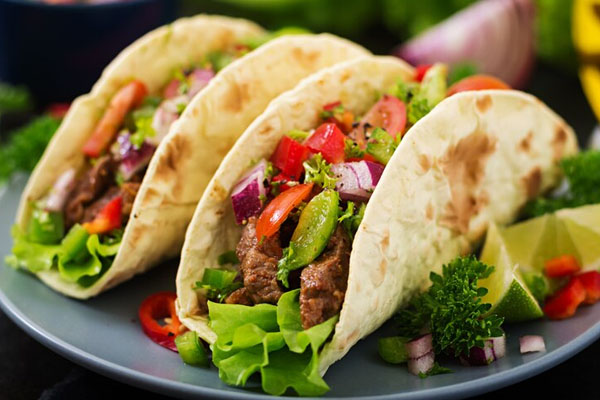Embark on a flavorful exploration of Mexico with our guide to Must-Try Mexican Dishes. Discover the rich, diverse culinary heritage that makes Mexican cuisine unforgettable.
Discovering Mexico’s Culinary Gems: A Tasty Adventure
Mexico’s cuisine is a vibrant tapestry of flavors, each dish telling a story of cultural fusion and tradition. From street food to sophisticated dining, the variety is astounding. This journey through Must-Try Mexican Dishes will not only tantalize your taste buds but also enrich your understanding of Mexico’s diverse culinary landscape. Let’s dive into the heart of Mexican cuisine and explore its most iconic and beloved dishes.
First on our list is the world-renowned Tacos, a staple in Mexican cuisine. Next, experience the rich and hearty Pozole, a traditional soup that’s a festival in a bowl. Don’t miss trying Tamales, a comfort food wrapped in corn husk. Savor the complexity of Mole, a sauce that’s a symphony of flavors. Chiles en Nogada, with its patriotic colors, is a dish that’s as visually stunning as it is delicious.
Continuing our culinary journey, indulge in the simplicity of Elote, a street food delight. Quesadillas, customizable and universally loved, are a must-try. For seafood lovers, Ceviche offers a fresh taste of the ocean. Enchiladas, smothered in chili sauce, are a fiery treat. Lastly, the sweet and savory Carnitas will leave you craving for more. Each dish is a unique experience, embodying the spirit of Mexican cuisine.

Tacos: A Quintessential Mexican Delight
Tacos, the quintessential Mexican street food, are a symphony of simple yet bold flavors. Originating from the indigenous people of Mexico, tacos have evolved into a global phenomenon. Each region in Mexico offers its own unique twist on this classic dish. From the soft corn tortillas of the south to the hard-shell tacos of the north, the variety is endless. Tacos are not just food; they’re a cultural emblem of Mexico.
The beauty of tacos lies in their versatility. Traditional fillings like carne asada (grilled beef), carnitas (slow-cooked pork), and al pastor (marinated pork) are just the beginning. Vegetarian options abound, with fillings like grilled cactus and spicy mushrooms. The key to an authentic taco experience is the fresh, handmade tortillas, topped with a choice of salsas, ranging from mild to fiery, and a sprinkle of fresh cilantro and onion.
For a true taste of Mexico, one must try tacos in their many forms. From the bustling streets of Mexico City to the sandy beaches of the Yucatan, tacos are everywhere. Each bite is a journey through the rich culinary landscape of Mexico. Tacos are not just a Must-Try Mexican Dish; they are an invitation to explore the heart and soul of Mexican cuisine, a true culinary adventure.
Pozole: A Rich Tapestry of Mexican Flavors
Pozole, a traditional Mexican stew, is a culinary masterpiece steeped in history and flavor. Originating from the Aztecs, it’s a hearty blend of hominy corn and meat, usually pork or chicken. The corn undergoes nixtamalization, enhancing its unique flavor and texture. This stew is a celebration of Mexican heritage, simmered with fragrant herbs and spices like garlic, onions, oregano, and chili peppers, creating a rich, soulful broth.
The essence of Pozole lies in its regional variations: Rojo, Verde, and Blanco. Pozole Rojo, vibrant with dried chilies, offers a mildly spicy experience. Pozole Verde, with fresh herbs like cilantro, presents a refreshing twist. Blanco, devoid of chilies, relies on garlic and bay leaves for flavor. These variations showcase Mexico’s diverse culinary landscape. Toppings like shredded lettuce, radishes, avocado, and lime wedges add freshness and texture, elevating the dish.
Pozole is more than just a dish; it’s a cultural symbol, often served during special occasions and celebrations. Its rich history, tracing back to Aztec traditions, adds depth to its significance. Whether enjoyed in a bustling Mexican market or a cozy home kitchen, Pozole is a must-try Mexican dish, offering a taste of Mexico’s soul. Each spoonful is a journey through time, a celebration of flavors and traditions.
Tamales: A Flavorful Mexican Tradition
Tamales, a staple in Mexican cuisine, are a delightful blend of corn dough and various fillings, wrapped in corn husks. The process starts with roasting Poblano peppers, adding a smoky flavor. Some variations use Serrano or jalapeño peppers for a spicier kick. The corn dough, made from cornflour and lard, is whipped until fluffy, then combined with warm chicken broth, creating a soft, pliable base for these delicious parcels.
The filling of Tamales de Rajas includes the roasted peppers and Queso Fresco, a mild cheese that complements the peppers’ spiciness. The corn husks, soaked to become pliable, are then filled with the corn dough, salsa, cheese, and pepper strips. This combination of flavors and textures, wrapped and steamed, results in a dish that’s both comforting and rich in taste. Tamales are a celebration of Mexican culinary craftsmanship.
Tamales are not just food; they’re a cultural icon, often featured in celebrations and family gatherings. The art of making tamales is passed down through generations, each family adding their unique touch. When unwrapped, the steamy, aromatic bundle reveals a soft, flavorful core, making it a must-try Mexican dish. Tamales embody the warmth and richness of Mexican culture, offering a taste of tradition in every bite.
Mole Poblano: Mexico’s Culinary Masterpiece
Mole Poblano, often considered Mexico’s national dish, is a culinary marvel representing the fusion of Mexico’s rich history and diverse flavors. Symbolizes Mexican gastronomy, blending indigenous and European influences into more than just a sauce. Made with an array of ingredients like chilies, nuts, chocolate, and sesame seeds, this dish is a testament to the complexity and depth of Mexican cuisine.
The history of Mole Poblano is as rich as its flavor. With roots in Aztec culture, the word ‘mole’ comes from the Nahuatl language, meaning ‘sauce’ or ‘concoction.’ Legends suggest its creation in a Puebla convent or as a dish served to Hernan Cortes by Moctezuma. Regardless of its true origin, Mole Poblano embodies the syncretism of Spanish and indigenous cultures, a true reflection of Mexico’s mestizaje.
Mole Poblano’s preparation is an art, involving up to 30 ingredients, including multiple chili types, chocolate, and spices. This complex blend creates a rich, layered sauce, traditionally served over turkey or chicken. The dish is a celebration, often reserved for special occasions like Día de Muertos. Mole Poblano is not just a meal; it’s a cultural experience, offering a taste of Mexico’s history and its people’s creativity.
Chiles en Nogada: Mexico’s Patriotic Delicacy
Chiles en Nogada stands out in Mexican cuisine, not just for its unique flavors but also for its deep cultural significance. This dish features poblano chiles stuffed with a savory mixture of meat (beef and pork) and biznaga (candied cactus), offering a delicate sweetness. The stuffing process is meticulous, ensuring each chili is generously filled. The dish’s colors—green from the chili, white from the walnut cream sauce, and red from pomegranate seeds—mirror the Mexican flag.
The preparation of Chiles en Nogada is an art form, reflecting Mexico’s culinary heritage. The dish’s complexity lies in its diverse ingredients and the balance of flavors. The nogada, a creamy walnut sauce, is a critical component, adding richness to the dish. The pomegranate seeds not only add a burst of color but also a tangy sweetness that contrasts beautifully with the creamy sauce and the savory filling.
Chiles en Nogada is traditionally served in September, during Mexico’s Independence Day celebrations, making it a dish of national pride. The combination of flavors and textures—sweet, savory, creamy, and crunchy—creates a culinary experience that’s both sophisticated and deeply satisfying. This dish is more than a meal; it’s a celebration of Mexican independence, culture, and the skillful blending of ingredients that characterizes Mexican cuisine.
Elote: Mexico’s Beloved Street Corn
Elote, or Mexican street corn, is a quintessential Mexican snack, embodying the essence of Mexican street food culture. This dish transforms simple corn on the cob into a culinary delight. The corn is grilled to smoky perfection, then slathered in a creamy mixture of Mexican Crema and mayonnaise. The addition of lime zest and juice to the cream mixture infuses a tangy freshness, enhancing the corn’s natural sweetness.
The magic of Elote lies in its toppings. A generous sprinkling of Cotija cheese, a popular Mexican cheese, adds a savory depth to the dish. This is complemented by a dusting of chili powder, which introduces a subtle heat, elevating the corn’s flavor profile. The combination of creamy, savory, and spicy elements makes Elote an irresistible treat. It’s a simple yet sophisticated dish, showcasing the vibrancy of Mexican cuisine.
Elote is more than just street food; it’s a cultural icon. Found in the bustling streets of Mexico City and beyond, it’s a favorite during festivals and holidays. The dish’s popularity has spread to various parts of the U.S., where it’s equally cherished. Elote’s appeal lies in its ability to deliver complex flavors through simple ingredients, making it a must-try Mexican dish for anyone seeking an authentic taste of Mexico.
Quesadillas: A Versatile Mexican Classic
Quesadillas, a staple in Mexican cuisine, originated as a way to repurpose leftovers. Contrary to popular belief, traditional quesadillas didn’t always include cheese. The essence of a quesadilla lies in its folded turnover shape, not necessarily its cheese content. In Mexico, quesadillas are made with a variety of fillings, and specifying the inclusion of cheese is essential, especially in places like Mexico City where they are a popular street food.
The versatility of quesadillas is evident in their regional variations across Mexico. Northern Mexico prefers flour tortillas filled with Chihuahua cheese, while central and southern regions opt for fresh masa dough. The choice of cheese is crucial, with Oaxaca and Chihuahua being popular options. These cheeses, known for their excellent melting qualities, are integral to achieving the gooey, comforting texture that makes quesadillas so beloved.
Beyond cheese, quesadillas can include a range of fillings, from squash blossoms and huitlacoche to roasted potatoes and chorizo. The cooking method also varies, with some regions preferring fried quesadillas, while others toast them on a skillet or griddle. This dish’s adaptability allows for endless combinations, making it a perfect canvas for culinary creativity. Quesadillas are not just a meal; they’re a celebration of Mexican culinary diversity.
Ceviche: A Fresh Taste of Mexican Seas
Ceviche, a celebrated dish throughout Latin America, holds a special place in Mexican cuisine. Made from fresh raw fish cured in citrus juices, typically lemon or lime, and spiced with chili peppers, ceviche is a testament to the freshness and simplicity of its ingredients. Accompanied by local side dishes like sweet potato, corn, avocado, or banana, ceviche offers a delightful window into the diverse culinary practices along the Pacific coast of Latin America.
The preparation of ceviche is straightforward yet requires precision and freshness. The fish, often fluke, flounder, sole, halibut, or escolar, is cut into small cubes and marinated in a mixture of key lime juice, garlic, cilantro, ginger, onion, and fish stock. This marinade, known as Leche de Tigre, is the soul of the dish, imparting a vibrant, tangy flavor that perfectly complements the delicate fish.
Ceviche is more than just a dish; it’s a cultural symbol. Its preparation and enjoyment are deeply rooted in the coastal regions of Mexico, reflecting the country’s rich maritime heritage. The dish’s freshness, combined with the zesty and spicy flavors, makes it a favorite among locals and tourists alike. Ceviche is not just a culinary delight but a celebration of the sea’s bounty, making it a must-try Mexican dish.
Enchiladas: A Rich Tapestry of Mexican Flavors
Enchiladas, with a history dating back to the Aztecs, are a fundamental part of Mexican cuisine. The term ‘enchilada’ originates from the Spanish word ‘enchilar’, meaning ‘to season with chili’. This dish is a beautiful representation of regional diversity in Mexico, with variations including corn, flour, or plantain tortillas and fillings like fish, beef, pork, cheese, beans, or vegetables. Enchiladas are a canvas for culinary creativity, embodying the richness of Mexican flavors.
This recipe for enchiladas involves corn tortillas dipped in an authentic chili sauce, filled with pre-cooked shredded chicken, and is perfect for utilizing leftover meats. The sauce, made from scratch with ancho and Guajillo chilies, garlic, onion, vinegar, cumin, black pepper, salt, and tomato sauce, adds depth and complexity to the dish. The process of making the sauce from scratch, though an extra step, is crucial for achieving the authentic flavor of Mexican enchiladas.
The preparation of enchiladas in Mexico differs from the Tex-Mex version. In Mexico, tortillas are first dipped in chili sauce and then pan-fried, infusing each bite with spice. Corn tortillas are more traditional and authentic, but personal preference plays a role in the choice of tortillas. Enchiladas are not just a meal; they are a celebration of Mexican culinary traditions, offering a taste of history in every bite.
Carnitas: A Celebration of Mexican Heritage
Carnitas, meaning “little meats” in Spanish, is a dish with deep roots in Mexican history, dating back to before the founding of Mexico. This celebrated dish is prepared by slow braising various cuts of pork in its own lard, a technique known as “confit.” In Mexico, carnitas often take center stage at celebrations and are a popular Sunday meal. The dish is traditionally served in a warmed tortilla as a taco, accompanied by a variety of fresh and pickled vegetables.
The origins of carnitas are believed to trace back to a celebration organized by Hernán Cortés in 1521. The dish originated from necessity as Cortés used pig and its lard, the only available cooking oil. This method of cooking, combined with corn bread (thick corn tortilla), gave birth to the iconic “taco de carnitas,” a staple in Mexican cuisine.
Michoacán, famous for contemporary carnitas, boasts a strong pork culture and iconic copper pots in carnitas preparation. The two-step cooking seals pork in boiling lard, then slow braises it with salt, yielding succulent, tender meat. Carnitas celebrates Mexican traditions with rich flavors and textures, a must-try Mexican dish.
Conclusion
Exploring Mexico’s culinary landscape through its iconic dishes like Tacos, Pozole, Tamales, Mole Poblano, and Chiles en Nogada, reveals a rich tapestry of flavors and traditions. Each dish, from the street food marvel Elote to the sophisticated Carnitas, tells a story of cultural fusion and heritage. These Must-Try Mexican Dishes offer more than just a meal; they provide a journey through Mexico’s diverse and vibrant culinary history.
The versatility of Mexican cuisine is evident in the regional variations of Quesadillas and the fresh, seaside flavors of Ceviche. Enchiladas, with their ancient roots, showcase the evolution of Mexican cooking techniques. These dishes, deeply embedded in Mexican culture, are not just about the ingredients but also about the art of preparation, from the slow braising of Carnitas to the intricate layering of flavors in Mole Poblano.
In conclusion, Mexican cuisine is a celebration of flavors, colors, and textures. It’s a culinary journey that invites you to explore the depths of traditional cooking methods and the richness of Mexico’s cultural heritage. Must-Try Mexican Dishes offer unique and unforgettable experiences, from Tacos to Pozole..
III. Frenquently Asked Questions About France

Ryan Taylor, a seasoned traveler with over a decade of experience exploring Europe’s nooks and crannies, offers a wealth of knowledge and unique insights into the continent’s diverse cultures and landscapes. His passion for travel began in his early twenties, and since then, Ryan has journeyed through numerous European countries, collecting stories, tips, and a deep understanding of each destination’s unique charm. His blog entries are not just guides but narratives enriched with personal experiences, making every recommendation and piece of advice relatable and practical for fellow travel enthusiasts. With a keen eye for hidden gems and a love for sharing his adventures, Ryan’s writings are a treasure trove for anyone seeking to discover the beauty and richness of Europe.







